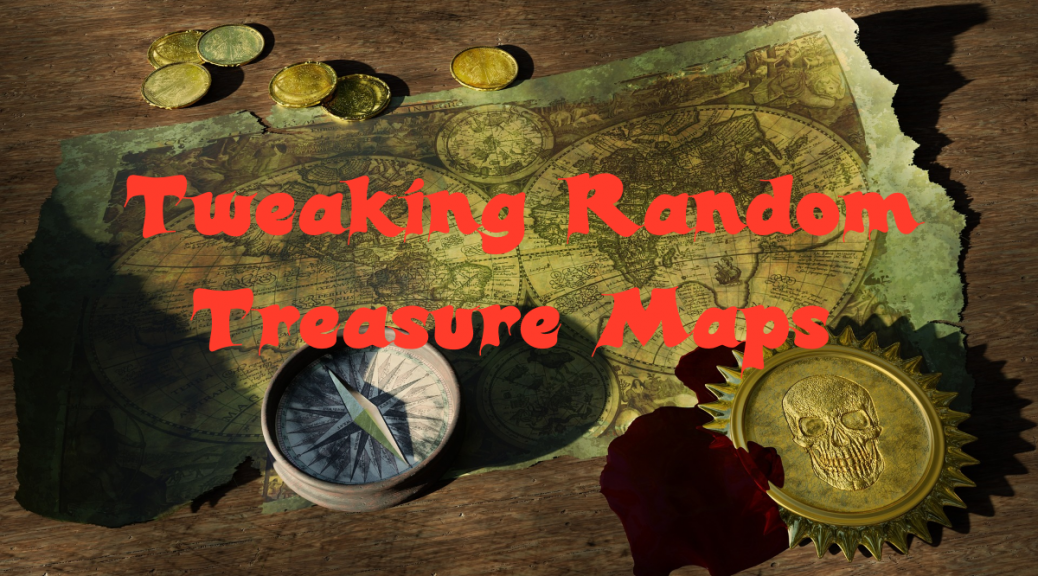An idea came to me to make treasure maps more interesting. I used a combination of a table from Kelri’s 4 – ENCOUNTERS Reference.pdf, page 130 gives 3 tables, a 2d8 table for the form of the map, a percentile table like in the 1e DMG for what the map goes to, and the best one a d10 table for the status of the treasure. This is on page 120 of the 1e DMG.
Surprisingly, OSRIC does not have tables for determining the type of map one finds. While AD&D assumes a treasure map, OSRIC just says the GM will have to make their own treasure maps.
Just because one has a treasure map does not mean that the treasure the map leads to is real, or if real, is still there. In the DMG, 5% of all treasure maps are false maps.What does that mean? The treasure is gone, or it’s like a scam where there is no really Lost Dutchman Mine, or the monsters in the dungeon are hoping to lead the adventurer’s away.
I combined the ideas from Kelri’s map table, the 1e DMG map tables, Grim’s all the dice Treasure Map Generator, and Richard LeBlanc’s New Big Dragon A to Z d30 Treasure Map Generator.
Grim’s table is a way to indicate landmarks, obstacles, or destinations on the map. The d30 map generator is one of 30 d30 PDFs written as part of the annual 2014 A to Z blogging challenge. It details the materials used for the map, the condition of the map, and the language or code it is written in.
My need for these map tables arose several years ago, in my home campaign, I created a map seller and decided to randomly determine how many treasure maps he had. The party bought every map he had in the general location where they were adventuring. I determined there were 32 maps and the party bought 17 maps. I then determined all kinds of things about the maps using all these resources, plus some additional things.
I built a spreadsheet to track it. The first column is Source, where did the map come from. I used the name of the map seller. I did not determine where he got them, so that is another layer one could add. Then I had Quality of the cartography, Size in square feet, Condition, Language, Details, General location depicted on map, Treasure status, 6 columns for the general terrain, landmarks, obstacles to put on the map, and Notes about exactly where a pristine or mostly pristine treasure is in the dungeon or other location. Determining treasure can also lead to their being more maps. Here is a link to a PDF of what I ended up with. Don’t ask me how I got to this point. It was just a mis-mash of different tables jammed into something I wanted. It was a lot of work.
This leads to all kinds of ways to use each map in game. Can the player’s read or decipher it? Is it good enough quality for the party to figure out where it is? And it the treasure still there?
For really large treasures, some are still “there”. That is there are in the general area, but have been found and moved and hidden by others who found it first. If the moved treasure is still there, it has either been found recently, or the finders never returned to claim it. If the moved treasure is “gone” it was either retrieved by the initial finders or still others. A large enough horde might get found and moved and hidden many times over the millennia as different groups find it and take what they can carry, and hide the rest hoping to come back later.
Some treasure might be found and dealt with in interesting ways. I have one treasure somewhere in my world that was found by a reclusive individual who built a shack over a treasure found by adventurers in the past who moved and buried it. The recluse is either unwise or untrusting, I haven’t decided yet, but won’t leave his shack except when in need of something, and only carries enough money to buy what he needs in town. Portions of the horde are scattered about his “range” so that he has multiple nest eggs in case something bad happens, but the treasure is so huge, he can never move it all on his own.
My idea is to create a PDF in the coming months with these ideas.
Generate random treasure maps and determine if the treasures are intact, partially looted, or cleaned out.
Cleaned out can be complete, bits in the corners left, smaller piles & stashes of coins in nooks, crannies, crevices, or ledges, or undiscovered rooms.
There are tons of maps available online for dungeons and other adventure locations, but I’m not aware of any maps that actually lead to these locations. Is there anyone out there creating treasure maps or maps to various locations?
Here is the companion podcast episode #116 from Thursday, May 9, 2019.



I’ve also got a two-part series of articles in The Twisting Stair on Treasure Maps, in issues #1 and #2. The first is “Combined Hoards as Adventure Hooks: Treasure Maps in the Mega-Dungeon (Part 1 of 2)” and the second part is “Treasure Maps: From Traditional to Engimatic”.
In addition, Philotomy Jurament wrote a piece in Knockspell #2: “Magic Swords & Treasure Maps” by Jason “Philotomy Jurament” Cone (again with some detail on the contents @ https://grodog.blogspot.com/2017/05/knockspell-magazine-master-index.html#issue2 if you’re curious).
Both are worth checking out 😀
Allan.
Thanks! Always looking for cool tables to generate some ideas!